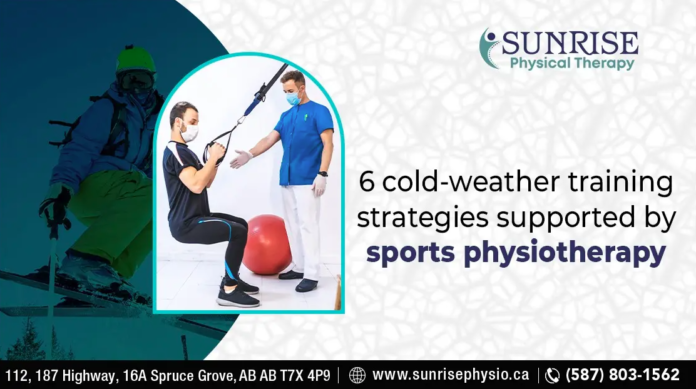Training during winter presents unique challenges, with cold weather often testing endurance, flexibility, and overall performance. Sports physiotherapy in Spruce Grove offers valuable strategies to navigate these challenges, ensuring that athletes can maintain peak form throughout the colder months. Tailored exercises and guidance help mitigate risks like stiffness, reduced circulation, and potential injury from icy or uneven surfaces. By adopting effective physio-supported approaches, individuals can continue their sports routines safely and efficiently, even in the most demanding winter conditions.
1. Warm-Up with Dynamic Exercises
Cold temperatures cause muscles to tighten, which increases the likelihood of strains or injuries. Performing a warm-up with dynamic stretches enhances muscle elasticity and prepares the body for physical activity. Dynamic movements, such as high knees, leg swings, and arm circles, improve blood flow and flexibility, creating an optimal state for exercise.
Exercise: High Knees
This exercise involves standing upright and raising one knee to hip level while hopping on the opposite leg. Alternating between knees at a consistent pace engages the lower body. Arm swings add coordination, and performing the movement for 30 seconds to one minute ensures sufficient circulation and muscle activation.
2. Layer Clothing Strategically
Cold-weather training requires clothing that balances insulation and breathability. Proper layering prevents overheating while keeping muscles warm, reducing stiffness and cramps. Moisture-wicking fabrics ensure dryness, while insulated outerwear retains heat. This approach protects the body from cold-induced tension and keeps training comfortable in winter conditions.
3. Focus on Core and Stability Exercises
Winter training often involves navigating slippery or uneven surfaces, increasing the potential for falls or missteps. Strengthening the core and stabilizing muscles enhances balance and coordination, ensuring safe movement. Core stability exercises support posture and reduce the strain on joints during activity.
Exercise: Single-Leg Stand
To perform this exercise, stand on one leg and lift the opposite leg slightly off the ground. Maintain this position for 20 seconds before switching sides. This movement improves balance by stabilizing muscles in the ankles, knees, and core. Consistent practice reduces the risk of injury from unstable surfaces.
4. Adjust Training Intensity Gradually
Sudden intense activity during cold weather can overwhelm muscles and joints, leading to strain. Gradual increases in exercise intensity allow the body to adapt safely. This progression prevents injury and ensures sustainable training sessions.
Exercise: Modified Push-Ups
Begin in a push-up position with knees resting on the floor. Lower the chest toward the ground, then push back up. This modified version minimizes stress while building strength. Completing 10–12 repetitions helps muscles adjust to gradual intensity changes without overexertion.
5. Protect Joints and Limbs from Overuse
Cold conditions exacerbate joint stiffness and discomfort. Mobility exercises target joint health, maintaining flexibility and reducing tension. These exercises ensure smoother movement and minimize wear and tear on the joints.
Exercise: Wrist Circles
Extend the arms forward and rotate the wrists gently in a circular motion. Perform ten rotations clockwise and counterclockwise. This movement increases mobility in the wrists and relieves stiffness, which is particularly beneficial for repetitive activities.
6. Incorporate Recovery Sessions
Recovery becomes even more critical in colder temperatures as the body’s natural healing processes slow. Incorporating activities like foam rolling, light stretching, and targeted exercises alleviates soreness and supports recovery. Recovery-focused strategies ensure long-term physical well-being.
Exercise: Hamstring Stretch
Sit on the ground with one leg stretched and the other foot resting against the thigh of the stretched leg. Lean forward gently toward the extended leg, holding the stretch for 30 seconds before switching to the other side. This movement reduces tension, improves flexibility, and aids recovery after intense sessions.
Combining these strategies with sports physiotherapy in Spruce Grove helps athletes stay active and achieve their goals even in winter. Tailored guidance ensures effective training, minimized risks, and long-term physical wellness.
Choosing the Right Training Environment
- Opt for Well-Lit Areas
Training in well-lit spaces ensures better visibility, diminishing the risk of accidents due to icy patches or uneven surfaces. - Check for Safe Ground Conditions
Prioritize dry or salted paths for outdoor activities to avoid slips and injuries caused by icy or wet ground. - Consider Indoor Alternatives
Indoor sports facilities, gyms, or community centers are excellent options for maintaining fitness when outdoor conditions are unsafe. - Wear Reflective Gear in Low Light
If outdoor training is necessary, wearing reflective clothing ensures visibility to others, especially during early mornings or evenings. - Adapt to Weather Changes
Be prepared to modify or reschedule workouts during extreme weather, ensuring safety without compromising training consistency.
Nutrition Tips for Cold-Weather Training
- Prioritize Warm, Energy-Dense Meals
Warm meals rich in protein and healthy fats, such as soups or stews with lean meats and legumes, help maintain body temperature and provide sustained energy. - Incorporate Complex Carbohydrates
Foods like whole grains, sweet potatoes, and oats offer slow-releasing energy to fuel longer workouts in cold conditions. - Stay Hydrated
Even in winter, dehydration can occur. Warm water, herbal teas, or electrolyte-rich beverages are effective for staying hydrated. - Snack Smart Before and After Workouts
Pre-workout snacks like bananas with nut butter or post-workout options like Greek yogurt with honey promote muscle recovery and sustained energy levels. - Include Immune-Boosting Foods
Citrus fruits, leafy greens, and foods rich in zinc or vitamin C help strengthen the immune system during the colder months.
Stay Active and Safe This Winter
Winter training can be both challenging and rewarding, but it’s important to prioritize safety and effectiveness. Sunrise Physical Therapy offers sports physiotherapy in Spruce Grove to support athletes in maintaining their performance while reducing the risks associated with cold-weather workouts. Whether it’s enhancing flexibility, preventing stiffness, or recovering from a setback, integrating sports injury physiotherapy into your routine can make a significant difference in achieving your goals.
Contact Sunrise Physical Therapy today to learn how personalized physiotherapy can help keep your training on track and support long-term athletic success.
